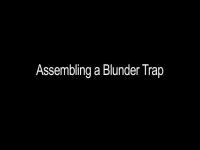Monitoring - traps
Monitoring using traps gives information about the insects, both pest and non-pest species in a space without having to go and look for them.
The traps have a sticky glue board; the insect or larvae walks onto the trap, gets stuck and is held in one place until the trap is checked.
Traps designed for insect pests should be used in museums. Traps for cockroaches have a card lip around the side and most insects find this too high to climb up.
Traps are generally one of three types:
Card blunder traps. These fold up into a triangle-shape and have a flat back, where the trap number and placement date can be noted.
Flat plastic traps. These are rectangular and are colourless. The gap through which the insects enter the trap is very tiny; consequently these are the best traps to use if bats are present.
Pheromone traps. These traps have a plastic holder in a long triangle, that holds a removable glue board. The glue contains a pheromone. There are several pheromones available, but the webbing clothes moth pheromone is the type of use to museums. Note that bullet lures, shaped like tiny test-tubes, also contain pheromones and these can be placed inside other traps.
Traps should be checked at least quarterly and the insects found should be recorded, along with the trap number on which they were found and the date of the check.
The traps have a sticky glue board; the insect or larvae walks onto the trap, gets stuck and is held in one place until the trap is checked.
Traps designed for insect pests should be used in museums. Traps for cockroaches have a card lip around the side and most insects find this too high to climb up.
Traps are generally one of three types:
Card blunder traps. These fold up into a triangle-shape and have a flat back, where the trap number and placement date can be noted.
Flat plastic traps. These are rectangular and are colourless. The gap through which the insects enter the trap is very tiny; consequently these are the best traps to use if bats are present.
Pheromone traps. These traps have a plastic holder in a long triangle, that holds a removable glue board. The glue contains a pheromone. There are several pheromones available, but the webbing clothes moth pheromone is the type of use to museums. Note that bullet lures, shaped like tiny test-tubes, also contain pheromones and these can be placed inside other traps.
Traps should be checked at least quarterly and the insects found should be recorded, along with the trap number on which they were found and the date of the check.
